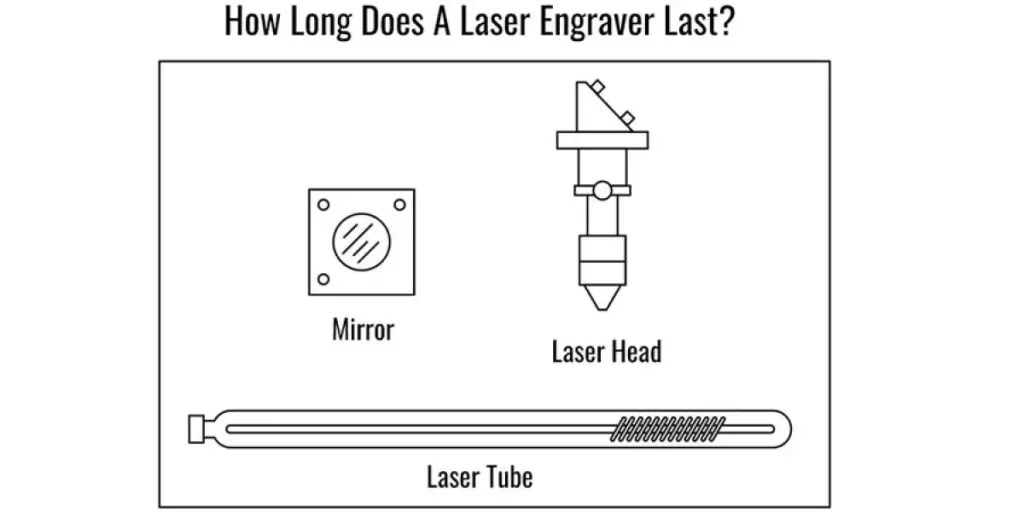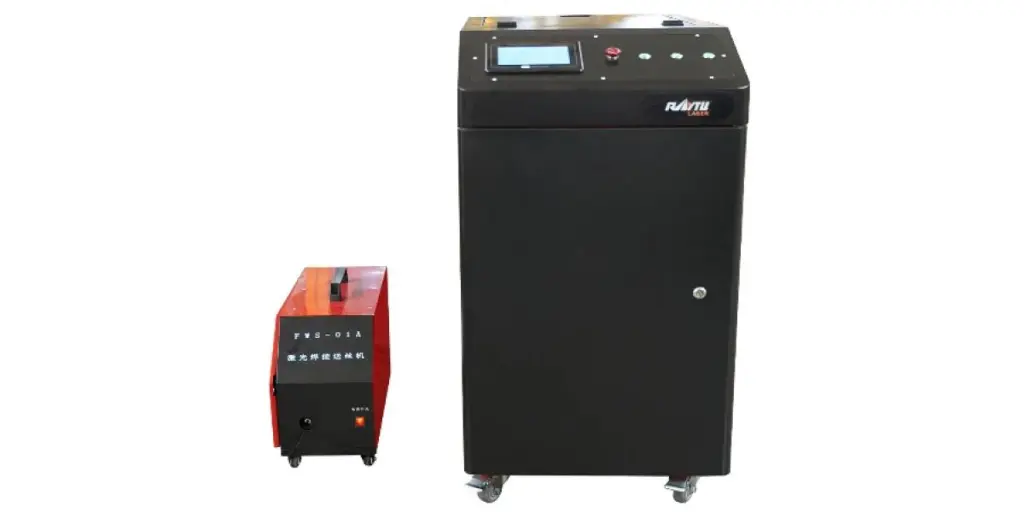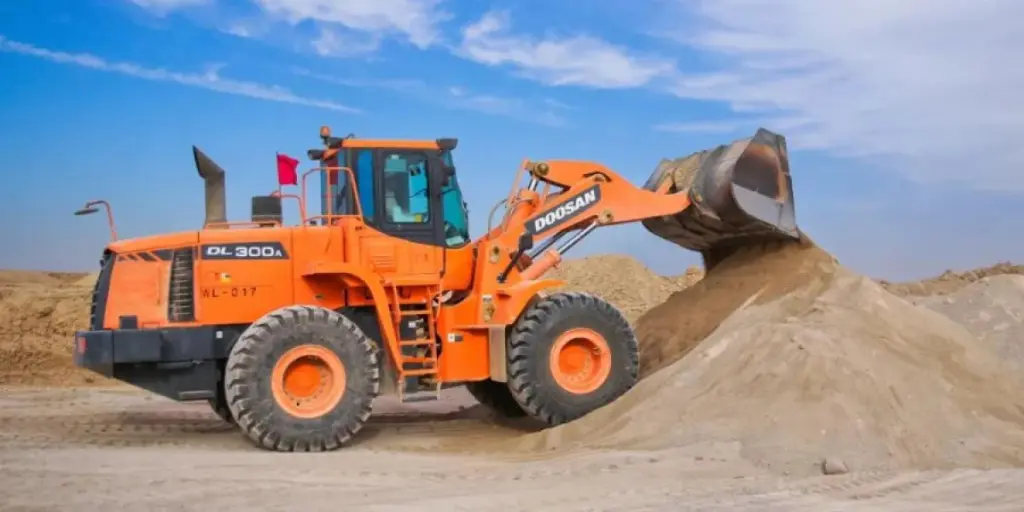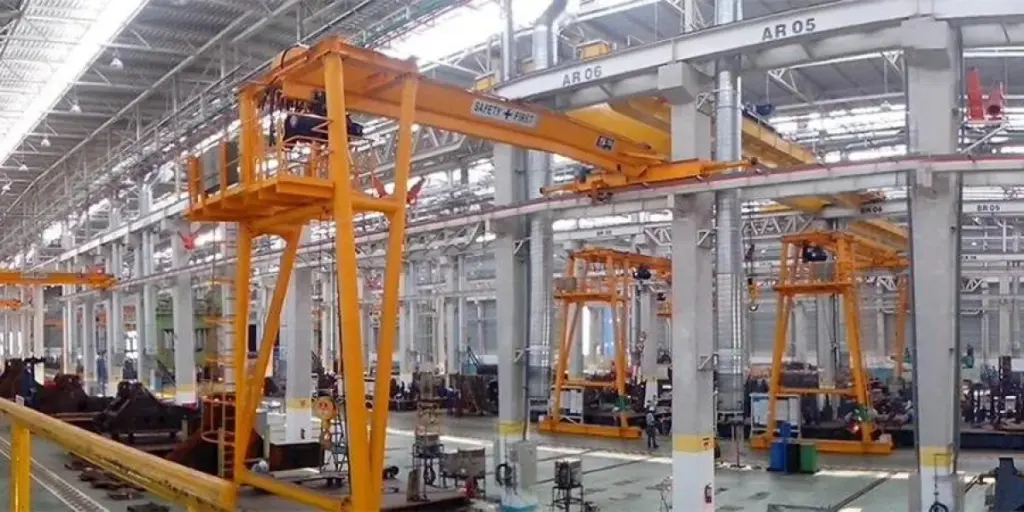How long a laser engraver lasts will depend on whether you can operate the machine correctly and whether you regularly maintain its components and parts.
A laser engraver kit has many parts, with each one playing an indispensable role. At present, most common laser engraving machines are composed of five parts: a control system, transmission system, optical system, auxiliary system, and a mechanical platform.
The mechanical system of a laser engraver is composed of mechanical accessories, such as a guide rail, cover, mirror frame, and so on. Its auxiliary system is composed of air compressors, water pumps, and exhaust fans. The transmission system consists of linear guides, stepping motors, belts, and gears. Finally, the optical system consists of a power supply, laser tube, mirrors, and a lens.
Each of these components has a certain service life. In this article, we will mainly discuss the lifespan of the laser tube and lens, as well as explain how to extend the service life of the whole laser engraving machine.
Table of Contents
Laser Tube Lifespan
Laser Lens Lifespan
How to Extend the Service Life of a Laser Engraver?
Summary
Laser Tube Lifespan
The laser tube is a key component of any laser engraving machine, meaning that its lifespan has become the most important purchase indicator for users.
Many users work with their laser engraver for 8 to 10 hours a day, meaning that the damage to the laser tube and other key components is significant. In these circumstances, a laser tube that should have been used for more than a year is often scrapped after only half a year. So, how long should a laser tube be able to work continuously before needing to be replaced?
The general life of a laser tube is 5,000-10,000 hours. In the state where the current ratio is relatively small, it would not be a problem for the laser tube to continuously emit light for 4 hours. In this instance, the laser tube itself will not become too damaged. However, when the laser tube is used continuously for over 4 hours, the temperature inside the laser tube will gradually increase. When the speed of the temperature rise exceeds the speed of heat dissipation in the laser tube, then the load of the laser tube will increase and the laser tube will be made to work continuously under high temperature conditions. In this instance, the lifespan of the laser tube will decline rapidly.
Although the water-cooling function can reduce the internal temperature of the laser tube and dissipate the heat, this effect is often not enough for a long period of continuous use. This is also the case for many electrical appliances. After a long period of use, the chance to dissipate heat will be lost and the appliance will continue to heat up. At this point, the laser tube will not be able to stand the heat. Thus, it is recommended to turn off the power after four hours of continuous work and to leave the laser engraver turned off for about half an hour before restarting work.
In addition, when the laser tube is made to work continuously for a period longer than 4 hours, the burden of the laser power supply will increase and the control board will become damaged to a certain extent. It is therefore recommended to avoid working with high currents or a high percentage of power, as this will shorten the service life of the laser tube as well as other key parts of the laser engraving machine.
Although a laser engraving machine’s laser tube is a component, replacing it less frequently will prolong the service life of the laser tube and reduce the overall cost of use.
Laser Lens Lifespan
There is no specific time limit for the life of a lens. This period may be one or two years, or it could be 1 minute. To ensure it is the former, pay attention to lens protection, wipe the lens often, do not get it dirty, and handle it with care.
When replacing the lens on a laser engraving machine, it is necessary to protect the lens from being damaged and polluted during placement, detection, installation, and other processes. Additionally, once a new lens has been installed, it needs to be cleaned regularly. This process is fairly simple, and ensuring correct operation and maintenance will effectively extend the service life of the lens and reduce the cost. On the contrary, its service life will be reduced.
When the laser machine is in use, the optical components in the laser tube will come into contact with the suspension. This is important, as when the laser engraves, cuts, welds, and heat-treats materials, a large amount of gas and spatter will be released from the working surface, causing damage to the lens. When contamination falls on the lens surface, it will absorb energy from the laser beam, resulting in a thermal lensing effect. In this instance, so long as the lens has not developed thermal stress, the operator can remove it and clean it. When cleaning, the right method should be used to avoid damaging the lens or leaving further contamination.
How to Extend the Service Life of a Laser Engraver?
Good Grounding
Both the laser power supply and the machine bed must have good grounding protection, where the ground wire should be a special ground wire of less than 4Ω. This helps to ensure the normal operation of the laser power supply, to prolong the service life of the laser tube, to prevent the machine tool from bouncing due to external interference, and to prevent accidental circuit damage caused by high-voltage discharge.
Smooth Cooling Water
Whether using tap water or a circulating pump, the water must be kept flowing. This cooling water reduces the heat generated by the laser tube. The higher the water temperature, the lower the optical output power (a water temperature of 15-20°C is best). When the water is cut off, the heat accumulation in the laser cavity will cause the tube end to burst, and it can even damage the laser power supply. Therefore, it is necessary to check the cooling water at all times. When the water pipe has a hard bend (dead bend), or falls off, and the water pump fails, it must be repaired quickly to avoid a power drop or damage to the equipment.
Cleaning & Maintenance
Cleaning and maintenance are essential for normal operation, and this applies to all the components of a laser engraving machine. For example, imagine if a person’s joints were not flexible, how would they be able to move? In this same way, a high precision guide rail is essential to functionality. After each job is completed, it must be cleaned and kept clean and lubricated. The bearings should also be regularly filled with oil, so as to make the drive flexible, process accurately, and prolong the service life of the laser engraver.
Ambient Temperature & Humidity
The ambient temperature should be in the range of 5-35°C. Special attention should be paid if the environment of use is below freezing point, as the circulating water in the laser tube must be prevented from freezing and the water must be completely released after the machine has been switched off. In addition, when starting up, the laser current must be preheated for more than 5 minutes before it can work. In a humid environment, meanwhile, the laser power supply requires a longer preheating time and a high voltage can be applied only after the moisture has evaporated to prevent the high voltage circuit from breaking down.
Keep Away from Equipment with High Power and Strong Vibration
A sudden high-power interference can also cause the machine to malfunction. Although this is rare, these interferences should be avoided as much as possible. This can be achieved by keeping the machine away from large electrical equipment, such as large electric welding machines, giant electric mixers, and large power transmission and transformation equipment. It goes without saying that strong vibration equipment, such as forging presses, vibrations caused from motor vehicles at close range, and any obvious shaking of the ground is very unfavorable for precise engraving.
Lightning Protection
The building’s lightning protection measures should be reliable. In addition, the section within this article on “Good Grounding” can help with lightning protection.
Tips:
In areas with unstable grid power (such as a voltage fluctuation of more than 5%), be sure to install a regulated power supply with a capacity of at least 3000W or more. This will help prevent sudden voltage fluctuations from burning out the circuit or computer.
The Stability of a Control PC
Except for installing the necessary graphic design software, please do not use the computer for any special purposes. The computer is equipped with a network card and an anti-virus firewall, meaning that any other purpose will seriously affect the speed of the laser machine.
Please do not install an anti-virus firewall on the controller. If you need the network card for data communication, please disable the network card before starting the laser engraving machine.
Rails Maintenance
When the guide rail is in movement, a large amount of dust will be generated by the material being processed.
Maintenance method: First, use a cotton cloth to wipe off the original lubricating oil and dust on the guide rail, wipe it clean, and then apply a layer of lubricating oil on the surface and sides of the guide rail.
Maintenance cycle: 7 days.
Fan Maintenance
Once the fan has been working for a period of time, a large amount of dust will have accumulated in the fan and the exhaust duct. This will affect the exhaust efficiency of the fan, resulting in a large amount of smoke and dust that cannot be discharged.
Maintenance method: Loosen the hose clamp connecting the exhaust pipe and the fan, remove the exhaust pipe, and clean the dust in the exhaust pipe and the fan.
Maintenance cycle: 30 days.
Screw Fastening
Once the motion system has been in operation for a certain period of time, the screws at the motion connection point will have become loose. This loosening of the screws will affect the stability of the mechanical movement.
Maintenance method: Use the supplied tools to tighten the screws one by one.
Maintenance cycle: 30 days.
Lens Maintenance
Once the machine has been in operation for a period of time, the lens will have become covered with a layer of ash from the working environment. This will reduce the transmittance and reflective capacities of the reflective lens, which will ultimately affect the working power of the laser.
Maintenance method: Use absorbent cotton dipped in ethanol to gently wipe the surface of the lens in a clockwise direction to remove dust.
Summary
Use your laser engraver in the correct way and regularly maintain it to ensure its long working life. By following the steps above, you can ensure that your laser graver serves your business better and its service life is extended.
Source from stylecnc.com
Disclaimer: The information set forth above is provided by stylecnc independentiy of Alibaba.com. Alibaba.com makes no representation and warranties as to the quality and reliability of the seller andproducts.




